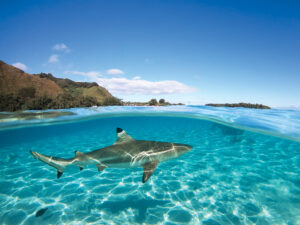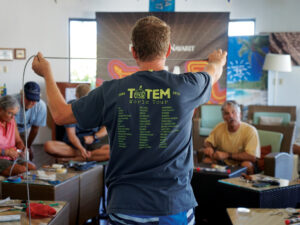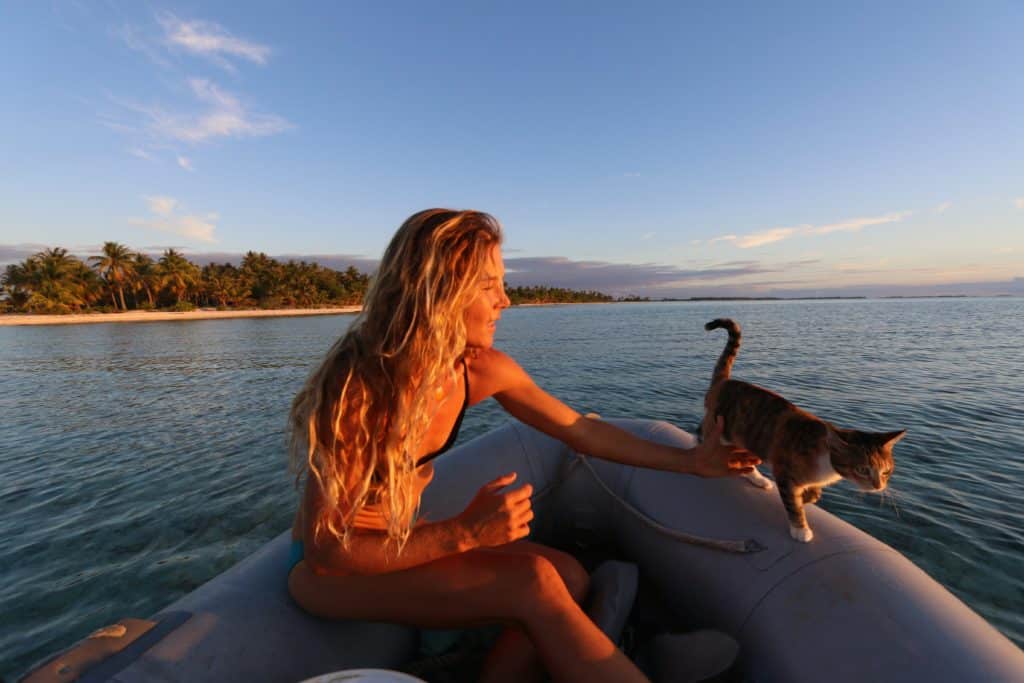
We were motoring into a turquoise French Polynesian lagoon when a 1966 Cal 40, already at anchor, caught my eye. Dropping our hook 50 yards away, we were close enough to read the wavy liquid typeface on the stern quarter: Swell.
“I know that boat,” I said to my wife and two girls. A dinghy tugged at its painter behind the Cal, but nobody was topside. My youngest daughter and I jumped in and swam over.
A tanned, smiling face popped up from the companionway, framed in long, curly blond hair. “Hi!”
I was face to face with the owner of the Cal, and she didn’t know me from Adam. But far away, bathed in fluorescent light and surrounded by the vanilla-colored walls of a Washington, D.C., office, I’d started rooting for Liz Clark upon discovering her blog in 2004. That was a year before she broke free.
At 25 years old, Liz sailed away from a Southern California marina, and she’s been exploring the world ever since. Parts of her story have been told in newspapers, magazines, on her blog and, lately, via social media. It’s a story she’s keen to share.
“I want people to know that I am not some superwoman to whom destiny opened the door to a perfect sailing dream life. Looking back through my diaries and logbooks, I am amazed to see just how far I have come,” Liz told my daughter and me as we chatted in her cockpit. “I now see how all the difficulties appeared so perfectly along my path for my personal growth.”
The challenges Liz faced to get where she is today were both physical and emotional. She overcame them through determination, perseverance and a sweet dose of serendipity.
In her early 20s, Liz was a bartender finishing a degree in environmental science. Up to that point in her life, she’d followed the path, jumped through the hoops. All she could then see on the horizon was convention: career, marriage, house, family, retirement. But she wasn’t after convention. She harbored an unconventional dream.
Liz grew up in a sailing family. As a young teen she’d read Tania Aebi’s Maiden Voyage and decided she also wanted to sail alone around the world. In the years that followed, on sailing trips with her dad between her Southern California home port and the nearby Channel Islands, Liz stood at the helm, pretending nobody else was aboard. Then she found herself suddenly in her 20s, not circumnavigating but tending bar. She’d long passed the point where pretending sufficed.
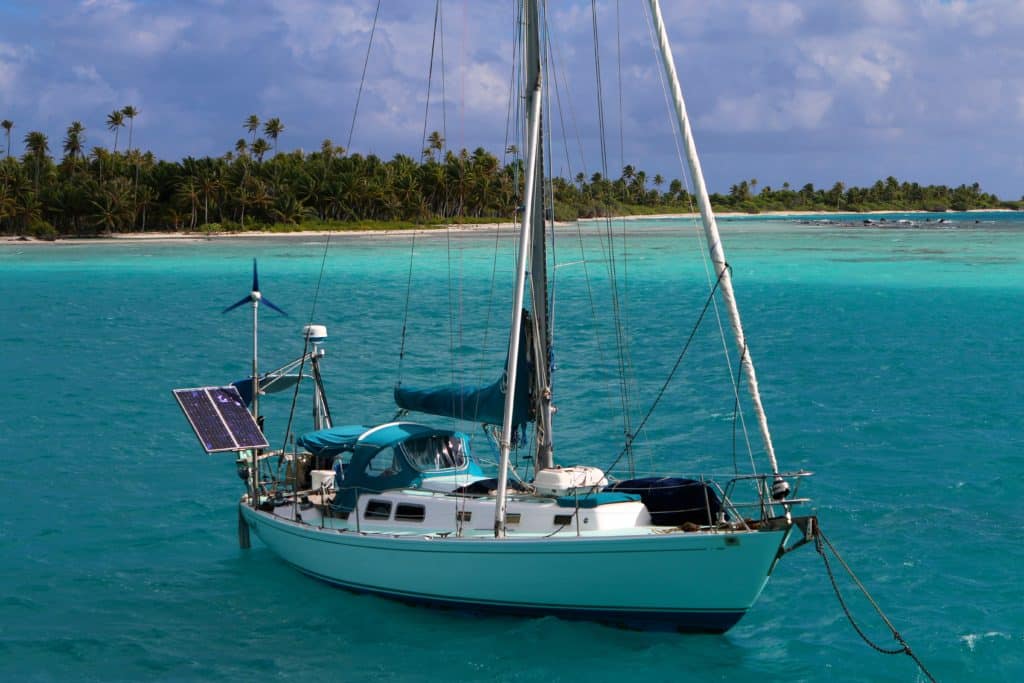
She didn’t own a boat, but she had a surfboard. For Liz, surfing was a second passion. She’d competed for the University of California and was named the College Women’s National Surfing Champion in 2002. But post-graduation, as she sat on her board outside familiar breaks, her attention was often drawn seaward. She wondered about undiscovered surf spots over the horizon, ones she longed to visit on a boat of her own. As happens to many plans and ambitions on the path to adulthood, Liz’s could have been forgotten. But she stayed focused. There wasn’t anyone in her life at that time who didn’t know about her dream.
Liz was working at yet another catering gig when someone at the party asked her whether she’d ever met professor Barry Schuyler.
“Nope,” Liz replied.
“You should,” the guest said. “He’s over there.”
More than a retired, white-haired academic, Dr. Arent “Barry” Schuyler was a sailor. He quickly invited Liz to join other students and professors for a weekend sailing trip. Sailor Barry and sailor Liz hit it off, and they kept in touch as time passed.
About a year after finishing her degree, Liz ran into Barry again. At 80, he was finding sailing to be more difficult. He saw in his friend Liz a chance for a vicarious sailing adventure. The aging professor offered the young dreamer his Contessa 26 to sail around the world.
For a blissful summer, Liz stole every day she could to sail Freya. Not only was she alone at the helm of this precious gift, but Freya was the same model boat that Aebi, the teen circumnavigator who inspired her, had sailed around the world. Liz enjoyed beam-reach sailing out to Santa Cruz and San Miguel islands. She beat north almost 100 miles from Santa Catalina Island. She got slammed off Point Conception, getting pooped several times over the low transom. Although Liz thought the Contessa was an excellent sailing boat, she found it to be a poor home.
“I couldn’t stand up straight in the cabin, there wasn’t room to host even one friend aboard, and bringing surfboards would have been nearly impossible,” she told us. “At that point I was a total surf rat. My sailing dream was as much about surfing as circumnavigating. Freya wasn’t quite big enough to live that dream. It was really hard to come to realize this. I felt like I was passing up my only chance.”
Regretfully, she returned Freya to her patron. He was understanding, though she was devastated and again a sailor without a boat.
“A couple of weeks later,” Liz said, “Barry called me with a new proposal: Save half the money needed to buy the boat that’s right for me, and he’d match it.”
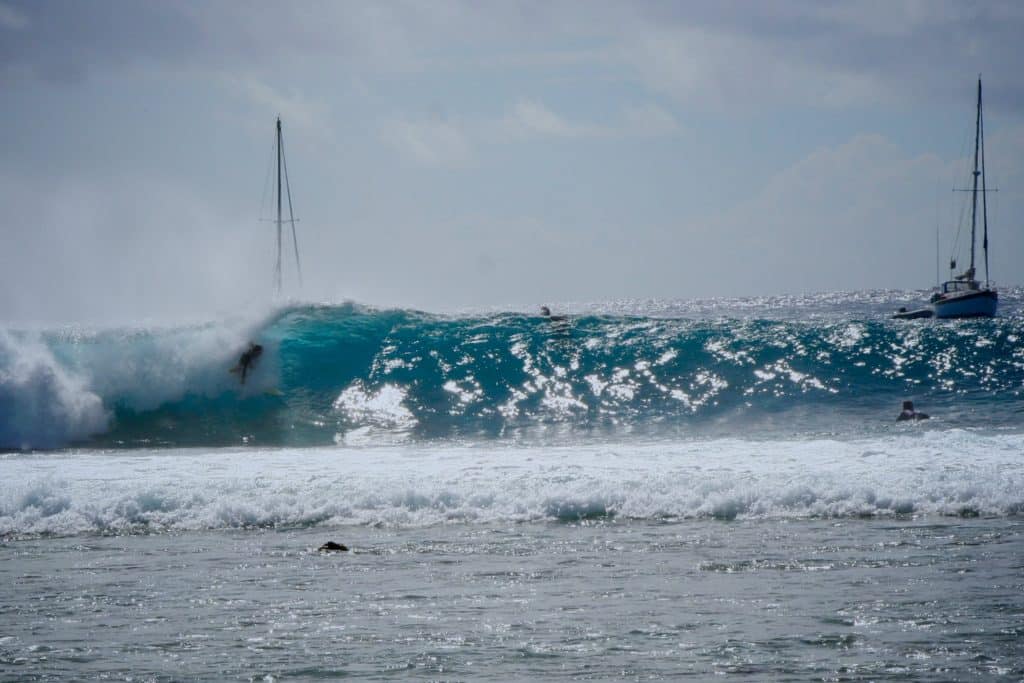
Ultimately, together Liz and Barry purchased Swell. The seeds of her future were sown — and the 1966 boat needed an extensive refit.
For the next 30 months, Liz bloodied her knuckles and washed dirt and dust from her hair each night. She used all the time she wasn’t waiting tables to prepare for an extended solo voyage. She apprenticed with a sailmaker, an electrician and a rigger. She studied at night for her ham radio license. Word spread through the Southern California sailing scene about the determined 20-something sprite with the 40-foot sailboat and big plans.
A local marine mechanic donated a replacement boom and mentored her on projects. Friends and family donated labor and supplies. Barry became an active member of her ground crew, weighing in on the refit to ensure the boat was prepped for offshore work. He and Liz plotted her voyage together. Every bit as much as the girl who hatched it, he wanted to see this dream realized.
After a local newspaper ran a story about the surfer and the professor, Patagonia contacted Liz and asked her to be one of its brand ambassadors. Liz’s enthusiasm went beyond the sport and the lifestyle; her passion for environmental awareness also aligned with the brand’s focus. More than a source of free products, Patagonia has been one of Liz’s primary sources of income ever since.
Another interest of the sailing and surfing environmentalist is writing. A year into Swell’s refit, Liz had already sold a couple of stories to Surfer magazine. Her blog was garnering a following, and Latitude 38, a West Coast sailing magazine, began reporting on her plans and her refit progress.
Finally, on a mid-October day in 2005, with the sun still working to pierce morning coastal fog, Liz motored out of Santa Barbara Harbor. “I was nervous, overwhelmed, excited, scared, victorious, and wondering whether I’d bitten off more than I could chew,” she said.
She ended up spending another month in a harbor farther south. There she finished projects like reinforcing the bow pulpit, installing an autopilot, and building a cradle and pulley system for a fixed spinnaker pole. “I’d felt pressure to cut the dock lines in Santa Barbara. It was two weeks later than the departure date I’d given the newspapers,” she said, “and I’d found it impossible to get any work done because curious people were always coming up to the boat to chat about my trip.”
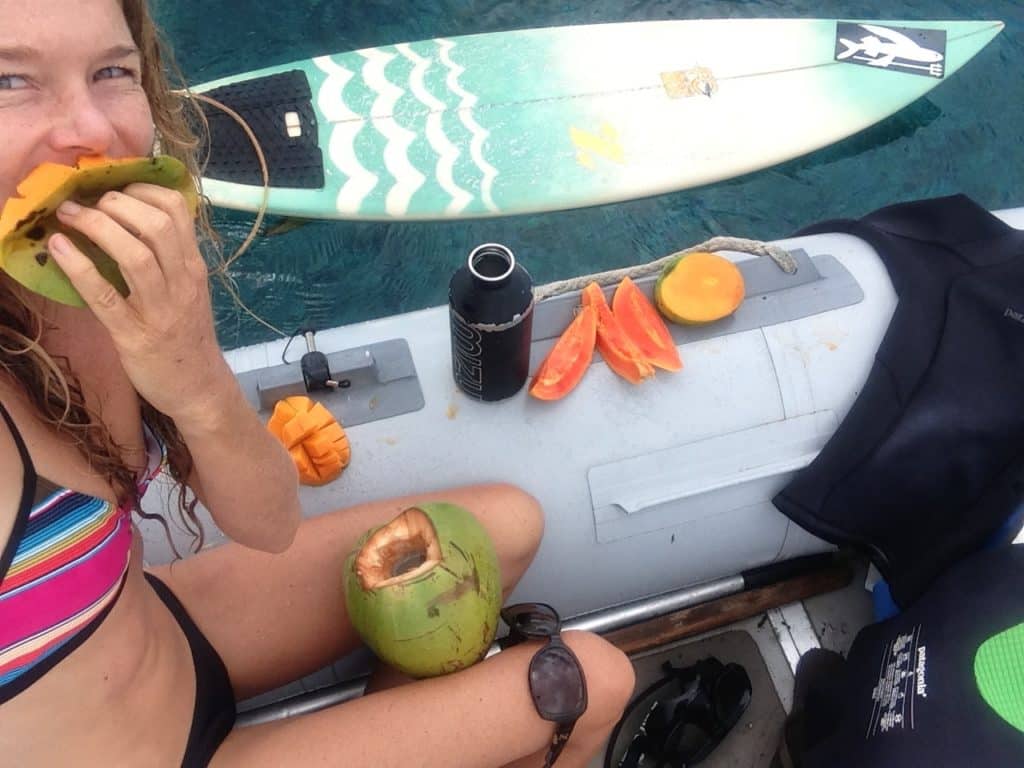
Liz spent the next couple of years between California and Panama, learning even more about her boat, sailing and weather. In 2007, she left the Galápagos with her mother as crew and landed 21 days later in the Marquesas. Since that voyage, Liz has made several long passages north of the equator, up the Line Islands, to escape cyclone season. She’s spent all of her time thus far in the Pacific, with plans to move on when it feels right.
Every day Liz dresses in flip-flops and swimwear. She maintains her boat and tends to sundry life chores, but spends the bulk of her time writing, sailing, surfing, hiking and preaching the gospel of environmental awareness and sustainable living.
The organization Women in the World recently profiled Liz for The New York Times. This past year, she was a National Geographic Adventurer of the Year finalist. Throughout the past decade, Liz’s online presence has grown massively. Readers cheered her on when for months she was in and out of a Polynesian boatyard, hot and sweaty, battling a persistent leak that she ultimately determined stemmed from Swell’s corroded bronze shaft tube. Fans from afar donated a headsail when hers could go no more.
Fulfilled dreams are contagious. In 2005, my wife and I were staring hard at the 20 years that remained before we’d realize our post-retirement cruising dream. We watched Liz cast off, and less than six months later, we started a five-year clock on our own cruising dream. Rather than go as a couple with white hair, we would launch as a family. In 2011, we sailed away in Swell’s wake. These days, in part because of Liz, I’m not staring at vanilla-colored office walls; I’m exploring South Pacific reefs with a mask and snorkel, my family around me.
Liz has inspired many of the current generation of young, adventure-seeking cruisers aboard classic-plastic sailboats. More than 1,000 nautical miles after meeting her, I shared an anchorage with Matt and Brittany Erickson, young cruisers aboard an Ericson 35 called Tipsea. Matt smiled when I mentioned that we’d met Liz in French Polynesia. “I would never have known about cruising — I’d never be out here — if it wasn’t for Liz Clark,” he said. “I was a teenage surfer when I first started reading about her. She absolutely inspired me from day one.”
Michael Robertson and his family are cruising the Pacific aboard their Fuji 40, Del Viento. Follow along on the Robertsons’ adventures at www.cruisingworld.com/delviento.

